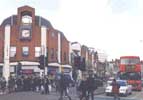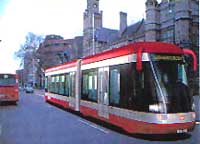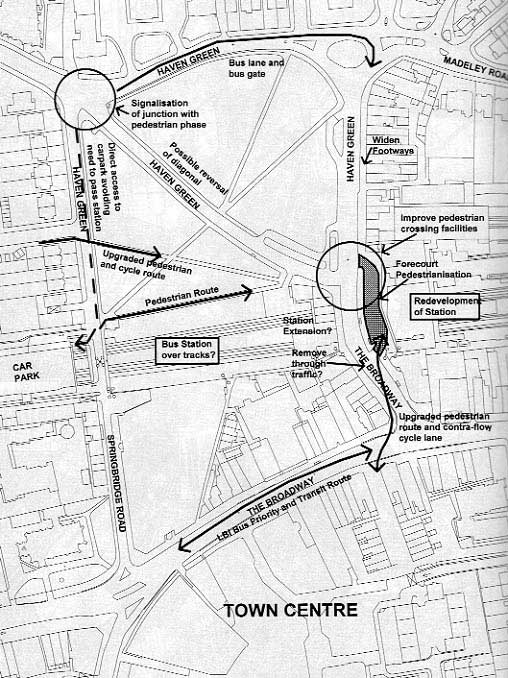|
|||||||
|
|
|
|
|
Tram Safety Ian Oliver has looked into Dutch safety statistics to see what we can learn from the Dutch experience with trams. • Four Dutch cities have trams: Amsterdam, Den Haag, Rotterdam, Utrecht. The Amsterdam network is significantly bigger than the others. • Trams have priority over all other vehicles, there are no legal limits on tram speeds. • The accident rate for pedestrians is 155 fatalities per billion tram kilometers The accident rate for cyclists and moped riders is 112 fatalities per billion tram kilometers. i.e. 267 fatalities to 3rd parties (excluding those in motor vehicles) per bn tram kms. • The respective rates for accidents with cars are 4.9 and 3.7 per billion vehicle urban kilometers. • A crude comparison with UK buses and coaches is that here there are 12 pedestrian/cyclist fatalities per billion bus kilometers. This is not a fully fair comparison as trams operate exclusively in high-density urban areas, buses and coaches don't. • Even with figures based on occupant kilometers trams come out badly: 3.6 cyclist fatalities per billion tram occupant kms, versus 2.7 fatalities per bn car occupant kms. • Trams are however very safe for their occupants: accident rates per passenger km are at the same level as trains and planes. • 70% of accidents are for "failing to give trams priority" (sic). • Most accidents (no figures) are at cross roads and there is a definite pattern of black spots (eg more than two parallel tram tracks is very dangerous). • There appears to be a wide variation in incidents per tram driver. • I could find no statistics for bike accidents caused by getting stuck in tram tracks and speaking to a number of people who cycle in Amsterdam on a recent visit there it was not perceived as a problem. |
|
|
|
Summing up the summer Once again it has been an eventful summer for Ealing Cycling Campaign. We held four events during Bike Week, including a Cyclists' Breakfast, and a Dr. Bike, and also ran a stall at the Countryside Weekend. Thanks are due to many people. First and foremost to Helen Mowat for organising the summer events this year. I for one was very grateful for her help, and am sorry to hear she is standing down from ECC. However it is for a good cause as she will now concentrate on fundraising for a local cancer centre. Goodbye too to Tom Williams who has pedalled off to live in France. We will miss his enthusiasm. Thanks also to everyone who manned stalls, fixed bikes, handed out leaflets and led bike rides. Finally thanks to Waitrose in West Ealing who sponsored the Cyclists' Breakfast. Colin McKenzie conducted a survey of cyclists who attended the breakfast. Thirty-four cyclists stopped and could be counted: 23 male, 9 female, 2 not recorded! Most were regular cyclists. Destinations or start points were as far away as Hayes, Northolt, Southfields, Neasden and Westminster. The median journey time was 30 minutes, and the mean, 27 minutes. |
|
|
|
Campaign News This year reports have been coming through the letter-box thick and fast.. The most interesting is Central Ealing Area Transport Strategy 2001-2. It suggests implementing one of our long-standing proposals — a contra-flow cycle lane between the Uxbridge Road and Ealing Station. It's great to see this is still on the cards, but the strategy misses the opportunity of opening up access to North Ealing from the station. Unfortunately the proposed route stops at the station instead of running up to Madeley Road. Elsewhere, the report contains other positive suggestions: an east-west route from Ruislip Road along Scotch Common then Meadvale Road and Brunswick Road, crossing under the A40; improvements to the route along the Avenue to West Ealing Station; and a new route into West Ealing across Jacobs Ladder, joining with a north-south route east of the Greenford rail line linking to Ruislip Road and Gurnell Pool. Although the strategy doesn't state so explicity, this would mean building a new pedestrian / cycle bridge over the railway line in West Ealing (the current bridge has steps).
|
|
|
|
Events:
Dates for 2002 Car Free Day: Sunday 22 September 2002 |

 Look Out! Here Comes the Tram.
Look Out! Here Comes the Tram.